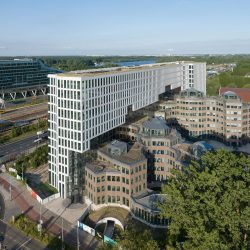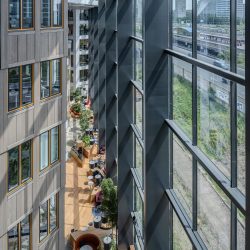
MVRDV . photos: © Ossip van Duivenbode
The construction of Trípolis Park, which renovates and transforms one of the last projects completed by the celebrated Dutch modernist architect Aldo van Eyck, is complete. On behalf of developer Flow, MVRDV restored two of the three listed heritage buildings in line with Van Eyck’s original designs and added a 12-storey “landscraper” along the edge of the site to shelter the complex (which includes Van Eyck’s Amsterdam Orphanage next door) from noise and dust generated by the adjacent A10 highway. The new building is careful in its relationship with the heritage buildings, keeping a respectful distance so that an exciting in-between space emerges where the two meet, with bridges crossing overhead to connect old and new.
The creation of Tripolis, a trio of idiosyncratic office buildings of 11,000, 8,000, and 6,000 square metres, was inextricably linked to Van Eyck’s masterpiece, the Amsterdam Orphanage. Completed in 1960, the orphanage was one of the most important projects of the Structuralist movement, yet by 1986 it was already threatened with demolition. A successful international campaign was launched to save the orphanage, and the municipality of Amsterdam offered the adjacent land to the developer – on the condition that Aldo and Hannie van Eyck should design the new office complex. In 1994, their new design was completed, and thus Tripolis began its life as the symbolic saviour of the orphanage.
MVRDV’s design makes the next step in this history. The original Tripolis did not prove commercially successful, standing empty for years. Meanwhile an upcoming expansion of the adjacent A10 highway, which includes a new on-ramp right alongside the Tripolis site, threatened to bring increased noise and pollution. Like the orphanage in the 1980s, the Tripolis buildings, in turn, needed an intervention to ensure their future. Following archival research and close collaboration with Van Eyck’s heirs, MVRDV’s design has restored the buildings’ façades not to their original state, but one step better: to Van Eyck’s initial designs. For example, the façades are now fully clad in wood, unlike the cheaper wood and granite combination requested by the Tripolis developer in the 1990s. The building’s multi-coloured window frames are also retained.
Inside, the renovation keeps characteristic elements such as the staircases and the natural stone floors, but it also adapts the buildings to bring them in line with modern standards, where offices are increasingly seen as spaces for meeting and collaborating. Dividing walls have been removed, so that the building is less compartmentalised, while various interventions make the building more sustainable. The roofs are now used more intensively, with greenery and pavilions that enable interaction between all users of the complex and which can be used for events. Solar panels are also introduced, helping the development achieve BREEAM Outstanding sustainability certification.
The project isn’t just a renovation, however: a 12-storey landscraper known as “The Window” stands on the edge of the plot, pushed as close as possible to the A10, to form a protective wall between the highway and the rest of the site. A large rectangular window has been cut from the gridded south facade of the 34,000-square-metre office building, offering a view upon the original Tripolis complex to emphasise the project’s heritage aspects. On the other side of the building, the northern facade responds playfully to the Tripolis buildings, indented by an “echo” of their complex shapes. This intervention creates an undulating interior, an exciting, low-noise intermediate space where bridges connect the old and new buildings.
With Tripolis Park, Van Eyck’s monument is re-established within the current office rental market, evident in the fact that it has attracted two prestige tenants in Uber and law firm De Brauw Blackstone Westbroek. In the coming years, work will continue on the third of the original Tripolis buildings. The greening of the site, which will be easily accessible via walking and cycling paths from the other parts of the Zuidas and the nearby metro station, will also continue, forming a park-like campus in which Aldo van Eyck’s buildings – from 1960 and 1994 alike – are sheltered and preserved.
_
Project Name: Tripolis Park
Location: Amsterdam, The Netherlands
Year: 2018–2023Client: Flow Development
Size and Programme: 61,000m2 Offices, Public amenities
Credits
Architect: MVRDV
Founding Partner in charge: Winy Maas
Director: Gideon Maasland Associate Design Director: Gijs Rikken Project Leader: Rik Lambers, Bob de Rijk Design Team: Steven Anton, Roxana Aron, Guido Boeters, Teodora Cirjan, Joao Viaro Correa, Guillermo Corella Dekker, Karolina Duda, Cas Esbach, Valentina Fantini, Rico van de Gevel, Piotr Janus, Nika Koraca, Urszula Kuczma, Claudia Mainardi, Sanne van Manen, Rugile Ropolaite, Irgen Salianji, Maxime Sauce, Claudia Storelli, Karolina Szóstkiewicz, Laurens Veth, Olesya Vodenicharska, Mark van Wasbeek, Mariya Badeva, Rebecca Fiorentino, Nefeli Stamatari, Michele Tavola,
Aleksandra Wypiór
Visualisations: Antonio Luca Coco, Luca Piattelli, Kirill Emelianov, Pavlos Ventouris, Francesco Vitale
Copyright: MVRDV Winy Maas, Jacob van Rijs, Nathalie de Vries
Partners
Co-architect: Powered by EGM Contractor: G&S Bouw Project coordination: Toussaint Project Management Landscape architect: Deltavormgroep Structural engineer: Van Rossum Raadgevende Ingenieurs Installations consultancy: Arcadis MEP: Bosman Bedrijven Cost calculation: BBN Building Physics & Environmental Advisor: DGMR Interior architect: Concrete



















































